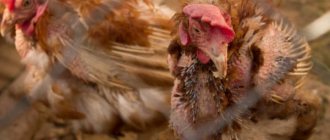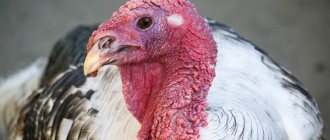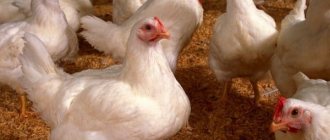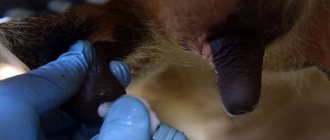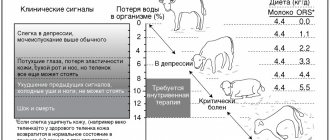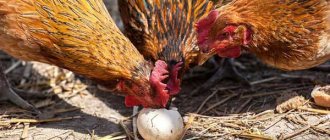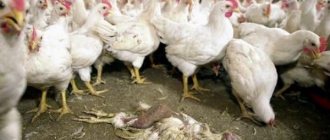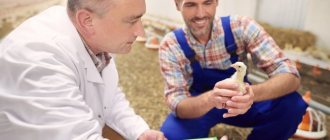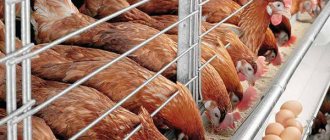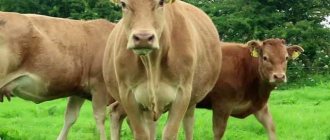According to statistics, the economic damage from chicken coccidiosis on a global scale is more than $1 billion per year. Losses include:
- mortality of young animals;
- reduction in weight gain;
- decreased productivity of laying hens;
- expenses for treatment and sanitation of premises.
On a small farm, losses from coccidiosis can also be significant. It is possible to minimize the economic damage from this widespread disease with ideal cleanliness of poultry housing, as well as timely identification of signs of coccidiosis in laying hens and chickens and initiation of proper treatment.
What is coccidiosis
Occidiosis (second name eimeriosis) is a parasitic disease caused by the protozoan eimeria (coccidia). They actively multiply in the intestinal tract of chickens and lead to lesions and damage to its mucous membrane.
As a result, inflammatory processes and intestinal bleeding develop. The bird’s digestion is disrupted, and the immune system drops, which often results in bacterial damage to the intestines.
With coccidiosis, chickens experience diarrhea mixed with blood.
The parasite produces up to 2 million new protozoa in a week, and conventional antiseptic drugs are ineffective against it. Simple means of disinfecting the poultry house do not cope with the pathogen, and its oocysts remain on the floor and litter. You can bring coccidia into the chicken coop on shoes, equipment or with hay used for nests.
Chickens aged 10 to 90 days are most sensitive to the parasite.
Pathogens in the intestines first reproduce asexually. When their number becomes significant and the limit of asexual reproduction has been exhausted, they reproduce sexually.
The parasite produces up to 2 million new protozoa in a week, and conventional antiseptic drugs are ineffective against it
Oocysts of the pathogen are released into the environment through chicken droppings. With them the bird becomes infected for the second time. If you exclude re-infection with the parasite, the chicken’s chances of recovery increase. There is no irreversible tissue damage during the first infection with the parasite.
Features of the disease in chickens and young animals
The course of the disease in young animals has its own characteristics. This is due to the insufficient immunity of chicks and young birds. At the beginning of the disease, it is impossible to notice the infection. An infected chicken appears completely healthy in appearance.
During the incubation period of the disease, it is a source of infection for others, and the parasite actively multiplies in the body. Symptoms appear with severe damage, when treatment is no longer always effective.
Coccidiosis is the leading parasitic disease in poultry farming
The death of chickens occurs after 3-7 days. Some individuals live 10-14 days. The disease progresses rapidly. Chickens do not eat or almost do not eat, they develop hunger edema. When the dead chicks are autopsied, their stomachs are full of liquid droppings mixed with blood.
Important! Broiler chickens, when sick, begin to eat more actively, but quickly lose weight.
Features of the disease in adult chickens
Adult chickens can only become ill with coccidiosis if they are not kept properly or if there is a particularly severe outbreak of the disease. The disease lasts longer than in chickens, and the bird’s survival rate is higher. Without treatment, in the acute form of the lesion, about 80% of adult birds die, and among chickens the mortality rate is almost 100%.
Coccidiosis infection occurs through dirty feeders and drinkers.
In adult chickens, the pathology can have a subacute course, and then the mortality rate is 10%. Coccidiosis with a subacute course has a long course.
Important! Chicken coccidia are not dangerous to humans, and infection cannot occur from a sick bird.
A bird with a strong immune system does not get sick when the parasite enters its body, but becomes its carrier and infects others. Chickens that have recovered from illness are also carriers, and it is extremely undesirable to let them breed.
Be sure to read:
How to treat mycoplasmosis in chickens quickly and effectively, symptoms of the disease, can you get infected?
Symptoms of coccidiosis in chickens
Chickens become infected with coccidiosis from the first days of life, mostly on days 4-8. During development, the gastrointestinal tract of the chicken begins to produce active chemicals that can destroy the oocyst shell, after which the causative agents of coccidiosis actively multiply and the disease manifests itself clinically when the young animals reach the age of 20-45 days.
Signs of coccidiosis development in chickens:
- oppression - hens and chicks sit in one place, crowd together, strive for heat sources, drowsiness is observed;
- lack of appetite, first reduced water intake, then thirst;
- the plumage is dirty, dull, untidy, disheveled, wings drooping;
- diarrhea is characteristic - at first greenish, then brownish-brown, with bloody streaks, and later with blood;
- the goiter is stretched, filled with air or liquid;
- chickens fall on their feet - paresis and cramps of the limbs develop;
- The egg production of chickens decreases, the eggshell becomes thinner;
- The comb and earrings of adult chickens turn pale.
Small chickens that are severely infected with coccidiosis and left untreated die within 5-10 days from the moment symptoms appear; the mortality rate can be up to 70-80%. Surviving individuals develop poorly and do not reach productive conditions.
Paresis of limbs in a chicken with coccidiosis
Older chickens tolerate the disease more easily, continuing to be carriers and spreading coccidia, while slowing growth and greatly reducing productivity. Such chickens are characterized by weakened immunity, and they are prone to contracting all kinds of infections.
Signs and development of coccidiosis in broilers
Symptoms and course of the disease
Symptoms of the disease depend on its form and the age of the bird. They appear at a time when the chicken is already in a rather serious condition, and its treatment turns out to be difficult.
With subacute coccidiosis, the prognosis is better, the chicken is not so emaciated and its digestion is not catastrophically impaired.
In the acute form of the disease, symptoms are observed:
- loss of appetite until it is completely lost;
- deterioration of the pen;
- excessive thirst;
- drop in egg production until it stops completely;
- diarrhea with foam and blood;
- dirt on feathers near the cloaca;
- blue skin;
- general lethargy;
- lack of coordination in chickens.
If left untreated, the chicken's condition worsens. She stops being active and her movement is difficult. A sick bird mostly sits motionless in a corner with its eyes closed.
Due to diarrhea in chickens and chickens, the feathers around the cloaca stick together or fall out
Instead of droppings, almost only blood is released. Changes in the intestines become irreversible, organ tissues become necrotic and completely stop performing their functions. Treatment is no longer possible, and the chicken is sent for slaughter.
In the subacute form, it is more difficult to establish coccidiosis due to the blurring of symptoms. The presence of pathology is indicated by the following manifestations of a violation of the bird’s condition:
- weight loss;
- lack of weight gain with maximum calorie nutrition;
- untidiness of the bird when the house is clean;
- lack of improvement in productivity from the use of stimulants;
- improvement of the condition of birds when using drugs against coccidiosis.
Important! In adult laying hens, the disease can have a completely hidden course, and its presence is indicated only by an improvement in egg production after a course of premixes with anticoccidiosis components.
The chickens' body is capable of secreting antibodies against the parasite, which, in case of mild infection, acts as a vaccination. The bird does not develop symptoms and, having overcome the pathogen, no longer becomes ill with this form of coccidiosis.
Description of the disease
Coccidiosis (coccidosis, eimeriosis) is an infectious disease that most often affects poultry. Chickens are no exception. This infection is more destructive for chickens, young animals under 3 months of age, as well as broilers - these categories of pets have weak immunity. Young individuals more often suffer from the acute form of eimeriosis, and in chickens that are resistant to bacterial infections (for example, laying hens), the disease takes on a chronic form.
Although coccidiosis is an infection, it can spread exclusively to animals of one species; it is not dangerous to other inhabitants of the farm. For example: if a chicken infects a duck or rabbit with this disease, the bacterium will die when it enters their digestive organs.
The causative agents of coccidiosis are protozoa, parasites from the coccidia subclass. In birds, this disease is provoked by about 9 types of dangerous parasites; chickens are more susceptible to infection with Eimeria tonella. It tends to multiply very quickly.
Oocysts (single-celled eggs) enter the bird’s body along with food and drinking water. Infectious spores enter the environment along with the droppings excreted by infected animals. They can also be found on the ground, grass and plant leaves. The carriers of these bacteria are insects. Chickens living in the same room infect each other very quickly.
Oocysts do not die from low temperatures and disinfectants. Only exposure to high temperatures is detrimental to eggs (a blowtorch is used to disinfect cages and the chicken coop).
Clinical picture of eimeriosis
When a chicken enters the body, the pathogenic flora actively multiplies and causes irreparable damage to the digestive organs.
Coccidiosis in chickens manifests itself in the form of the following symptoms:
- the bird's appetite decreases or disappears completely;
- the plumage becomes ruffled;
- the general condition worsens: the bird looks lethargic and weakened;
- thirst appears;
- the goiter swells;
- Laying hens begin to lay eggs rarely;
- the gait becomes unsteady, the bird may fall;
- diarrhea appears, often mixed with blood and mucus.
A sick pet loses weight sharply, its bedding becomes sticky and damp. If the necessary measures are not taken, the bird dies after 4–5 days. Sometimes it is very difficult to make a diagnosis, since the disease can occur in a latent form.
Reasons for appearance
The cause of the disease is the penetration of a pathological pathogen into the chicken’s body. If there are factors predisposing to the disease, the immune system will not cope with the attack of the parasite.
The chicken body is able to secrete antibodies against the parasite
Coccidiosis develops under the following conditions:
- feeding birds with spoiled feed;
- non-compliance with the rules for disinfection of feeders and drinkers;
- the presence of a person in the poultry house wearing shoes in which he walks outside the farm area;
- keeping poultry on dirty bedding;
- keeping birds unvaccinated against the disease;
- cold, dark poultry house.
Eliminating predisposing factors reduces the likelihood of coccidiosis occurring in chickens.
Sources of infection
The source of infection is a sick bird. Oocysts are brought into the chicken coop from another poultry house on their feet or with poultry care equipment. The disease can be acquired after visiting pet markets and poultry farms.
External signs are not enough for diagnosis
Without complete disinfection, you cannot use drinkers and feeders for your birds, both new and used.
Before moving new chickens into the poultry house, it is necessary to first thoroughly clean and disinfect the premises and walking areas.
This is necessary to prevent infection when in the old herd there were carriers of the parasite who excreted oocysts in their droppings.
Prevention of coccidiosis in chickens
In many ways, the development of coccidiosis in chickens is facilitated by violations of poultry management rules. To minimize the possibility of infection of young and adult chickens with coccidiosis, you need to follow some simple, but very important points in arranging chickens in the household.
- Keep the bedding dry and do not allow dampness in the house.
- Wash and periodically treat feeders and drinkers with disinfectants; treating heat-resistant surfaces with an open flame, for example, with a blowtorch, is effective against coccidiosis.
- Avoid crowding chickens, which is especially important when keeping poultry indoors all the time.
- If chickens are infected with coccidiosis, burn the litter; do not use it as fertilizer.
- If possible, provide chickens with more light, air and the opportunity to forage on the run.
- Keep different age groups separately; if coccidiosis occurs, isolate the sick bird.
Specific means of preventing coccidiosis in chickens
When keeping a large number of chickens, as well as in farmsteads unfavorable for coccidiosis, the use of specific medications to prevent the disease is effective.
Avatek
The drug Avatek 15% CC has a pronounced effect on all main types of poultry coccidia at different stages of parasite development. The product is not recommended for use in laying hens and breeding birds. If the dosage is observed, the active substance sodium lazolocid is excreted in the droppings over 3-4 days and exhibits its activity mainly on the mucous membrane of the gastrointestinal tract.
You cannot combine the use of Avatek with other coccidiostats, sulfonamides, and tiamulin. Restrictions apply during the period of application and for 7 days after completion of the course.
Avatek in the form of a powder for the prevention of coccidiosis is introduced into the diet of young chickens at the rate of 50 g per 100 kg of feed, thoroughly mixed with dry feed, and used according to the following schemes:
- broilers from one day of age throughout the entire growing period, excluding the drug from feeding 5 days before slaughter;
- to young chickens from one day of age, stopping feeding before the onset of the maturation period, that is, until the age of 16 weeks.
The powder is packaged in dense kraft bags of 20 kg.
Manufacturer: Pfizer, USA.
Diacox
The drug Diacox 0.2% acts on all types of coccidia and is used with feed to prevent coccidiosis in young poultry. The active substance diclazuril does not accumulate in tissues, does not cause consequences even with a severe overdose, the drug is compatible with other drugs, its use is permissible until slaughter, no holding period is provided.
Diacox can be mixed with any feed, subject to heat treatment and granulation.
The drug in the form of a poorly soluble coarse powder is thoroughly mixed with feed in a proportion of 50 g per 100 kg of feed and fed to the bird:
- broilers from one day of age until the end of fattening;
- for young chickens from one day of age to 16 weeks of age.
For high-quality distribution of powder in bulk feed, it is recommended to mix a small portion of 1-2 kg of feed well, and then add the resulting concentrate to the required volume according to the proportion indicated above.
The drug Diacox is packaged in 1 kg bags.
Manufacturer: Biopharm, Ukraine.
Diagnosis of the disease
External signs are not enough for diagnosis.
If the presence of parasite oocysts is detected in a chicken's droppings, in veterinary medicine this is regarded as a sign of carriage, but not of disease. The presence of the parasite in the intestines of a bird in small quantities is considered acceptable.
Officially, the diagnosis is made after a pathological examination of dead chickens from the herd.
When a bird is sick, its intestines are inflamed, with yellow nodules; inside the organ contains a lot of water and liquid droppings. Treatment of birds begins when external signs of the disease appear. If mortality begins, the prognosis for the livestock worsens.
Be sure to read:
Why the comb of chickens and roosters turns blue: reasons, what to do, preventive measures
How is coccidiosis transmitted?
The disease is transmitted in several ways:
- carried by insects;
- spread by wild birds coming into contact with domestic birds;
- through dirty dishes, water in the drinking bowl, food;
- from a sick individual to the rest (especially in crowded conditions).
Of particular danger is rainwater, which washes away feces. Outbreaks of coccidiosis most often occur on farms where, after rain, the owners did not clean the yard in time and the birds managed to drink water from puddles.
Low level of enclosure hygiene, water and food quality is the main route for the spread of pathogenic microflora.
Treatment methods
Treatment for the parasite is carried out with veterinary drugs or traditional methods. Special veterinary medicines for chickens have maximum effectiveness, the action of which is directed specifically at the causative agent of the pathology and does not lead to severe side effects.
Treatment for the parasite is carried out using veterinary drugs or traditional methods
When treating sick chickens, they are isolated. The poultry house is kept clean. The litter should be changed daily, and not just sprinkled on it. If possible, the chicken coop is irradiated with an ultraviolet lamp.
Veterinary drugs
Veterinary coccidiostatic drugs give rapid, pronounced results. The products do not interfere with the general condition of the bird, its development and further productivity. Veterinary drugs should be given to sick pets in therapeutic doses, and to those at risk - in prophylactic doses.
Baycox is an effective drug for the prevention and treatment of coccidiosis
All chickens in the poultry house are treated.
List of commonly used drugs:
- Baycox 2.5%. Use diluted with water. Therapeutic dose is 1ml/1l of water. This portion is consumed in two days. The prophylactic dose is reduced by 2 times. For prevention, chickens should be given water once a day.
- Amprolium. Added to feed. For medicinal purposes, 0.25 g of the product is added per 1 kg of feed. For prevention, the dose is halved. The treatment course lasts 1 week. To prevent the disease, chickens are given medicine from birth to 4 months.
- Coccidiovit. Preparation for adding to feed. For preventive purposes, add 1.25 g of the product per 1 kg of food to chicks up to 4 months old. Treatment requires increasing the dosage by 2 times. The medicine is given for 1 week.
- Avatek 15% CC. Added to food to prevent illness. Dosage 5 g per 10 kg of feed. In areas unfavorable for coccidiosis, the drug is given to chickens from the first day. Stop using the product 5 days before slaughtering chickens.
- Sulfadimezin. Medicinal drug. Not used for prophylaxis. Dose 1 mg per 1 kg of feed. The medicine is given for 3 days.
It is unjustified to treat chickens in serious condition.
It is unjustified to treat chickens in serious condition.
Even if the chicken survives, it will be weak, with low productivity.
How does coccidiosis develop in chickens?
To successfully combat and prevent coccidiosis, it is important to understand exactly how this disease develops in the body of chickens.
The life cycle of the coccidia parasite begins with a resistant form known as an oocyst, which is not yet virulent early on and cannot immediately cause disease.
Once in favorable conditions - a humid and warm environment at an optimal temperature of 25-30 ° C, the oocyst develops rapidly and becomes virulent in less than 24 hours.
The causative agent of coccidiosis
The difficulty in preventing and treating coccidiosis is aggravated by the resistance of coccidia at the oocyst stage - a thick shell protects this simple organism from cold, heat and most disinfectants. It is this fact, coupled with the high mortality rate of young poultry, that makes coccidiosis a most dangerous disease that can devastate a poultry house.
When the oocyst enters the chicken's stomach, active chemical compounds destroy its walls and the causative agent of coccidiosis becomes active, penetrating the intestinal mucosa. Subsequently, rapidly multiplying, the parasites infect and destroy cells in increasingly large areas of the intestine.
As a result, oocysts are again formed in the chicken’s body, which enter the external environment, infecting everything around. It is easy to imagine how quickly the situation in the poultry house can worsen if at least one chicken sick with coccidiosis stains the water in the drinking bowl or the feed with droppings.
Chicken with coccidiosis
Constant overinfection with new oocysts leads to a sharp deterioration in the condition of chickens with coccidiosis, and especially young animals, who lose strength in this unequal struggle, become unable to absorb nutrients, suffer from anemia and diarrhea, becoming even more exhausted and secreting more and more coccidia.
With the further development of coccidiosis, the natural balance of bacteria in the intestine is disrupted and pathogenic microorganisms intensively develop on the affected mucous membrane, leading to inflammatory processes and general intoxication of the body.
The fact that the smallest coccidia parasites predominantly develop on the intestinal mucosa causes the main symptoms of coccidiosis.
Folk remedies
Folk remedies are less effective than veterinary ones. They help at the very beginning of the disease and with strong immunity in chickens. It is not advisable to waste time using them.
List of popular means:
- Iodine or iodinol. It is recommended to give an antiseptic solution with food to hens and chicks in the morning. The solution concentration is 0.01%. The dose for chickens up to 40 days old is 2 ml of solution per head, from the 40th day to 60 - 5 ml. After three months, iodine is no longer added to the feed. The antiseptic is used equally for prevention and treatment.
- Osarol. The product is given with feed at the rate of 10g/1kg of chicken weight. The dose is fed in 2 doses during the day. Treatment lasts 5 days, followed by a 3-day break and repeating the course. In total, the administration of the medicine will be repeated 4 times.
- Feed sulfur. Added to poultry food in an amount of 2% of the feed portion. Give no more than 2 weeks. An overdose of the substance causes rickets in chickens.
Important! Recommendations to feed chickens with vodka are wrong. Alcohol will only make the bird worse, and it will be impossible to save it.
Nutrition
Feed is given to the bird at the beginning of the disease in small portions with a medicinal preparation . If the chicken completely refuses to eat, the food is mixed with the medicine, a small ball is formed from it and forcibly thrown into the beak.
Be sure to read:
Why do chickens and chickens die - what is this disease and what to do?
During treatment, chickens should not be given dry grain and raw chopped vegetables, which further damage the affected intestines. To prevent rickets, vitamin complexes must be introduced into the bird’s diet.
Feed is given to the birds at the beginning of the disease in small portions with a medicinal preparation.
If the chickens' appetite is not impaired, which is observed in broilers, foods that cause internal fermentation and raw grass and vegetables are excluded from the diet. New portions of the parasite may be introduced with them.
Chickens need to eat semi-liquid feed. In the first days, bran is added to one of the feedings to speed up bowel cleansing. If a bird is fed with compound feed, its nutrition does not change.
Premixes with coccidiostats
Premixes containing coccidiostats are quite effective, but in severe cases they will not help.
They are easy to use and recommended as a medicine for mild injuries and for prevention.
Premix is a powder that is easy to distribute in food. Compound feeds with premixes against coccidiosis are also produced. Their use is preventive.
The drugs are produced in industrial packaging in 30 kg bags, and for private households in packages from 500 g to 3 kg. The product can be given to chickens from 5 days.
Premixes containing coccidiostats are quite effective, but in severe cases they will not help
When feeding with premixes, there are no restrictions on the types of food; they are combined with all food for the bird.
Treatment of coccidiosis in chickens
Violations of the rules for keeping chickens, crowding and high humidity in the poultry house are of great importance in the spread of coccidiosis. Therefore, you should strive to keep the bird clean and provide spacious premises with good ventilation.
Drug treatment of coccidiosis in chickens includes three main components:
- coccidiostatics – to inhibit and destroy coccidia;
- antibiotics - to fight pathogenic bacteria that cause intestinal inflammation;
- probiotics - to restore normal intestinal microflora.
Coccidiostatics
Modern drugs for the treatment of coccidiosis are highly effective and not as dangerous as previously used drugs, which had to be strictly dosed - exceeding the concentration could lead to poisoning or even death of the bird. The following specific drugs are effective against coccidiosis in chickens.
Solikoks
The active ingredient diclazuril is effective against all types of coccidia in chickens. Solikox is a low-toxic product that can be used throughout the entire period of poultry keeping, and the exposure before slaughter is only 5 days, while the drug does not linger in the tissues, does not cause side effects even if the dosage is greatly exceeded, and is also acceptable for combined use with antibiotics , vitamins and premixes.
For medicinal purposes, drinking Solicox is used, which is a viscous cream-colored substance, diluted in water at the rate of 2 ml per 1 liter of water for 2 days. With this method of application, the required dosage will be achieved, which is 0.4 ml per 1 kg of bird weight.
Available in 10 ml bottles, as well as in 1 liter plastic containers.
Manufacturer: AT Biopharm, Ukraine.
Baycox 2.5%
The drug is used for the treatment of coccidiosis in broilers and young chickens before laying; the drug is not recommended for laying hens. Baycox is a colorless liquid; the drug has a quick and destructive effect on all types of coccidia.
Exceeding the dosage up to 10 times will not cause side effects - the active substance toltrazuril is excreted in feces over several days and has low toxicity. Use in combination with premixes, vitamins and antibacterial drugs is acceptable.
Baycox is administered when clinical signs of coccidiosis appear and is used according to one of the following regimens:
- 1 ml of a 2.5% solution is diluted in 1 liter of drinking water and given to the bird for two days;
- 3 ml of a 2.5% solution is diluted in 1 liter of drinking water and given to the bird twice within 8 hours for two days.
If necessary, the course of treatment of coccidiosis with Baycox is repeated 5 days after completion of the first course. The active substance remains active in dissolved form for 48 hours.
The holding period before slaughtering of the bird is 8 days.
Baycox is produced in ampoules of 1 ml, as well as in plastic containers of 1 liter.
Manufacturer: Bayer, Germany.
Antibiotics for the treatment of coccidiosis in chickens
One of the modern antibiotics that can be used together with the selected coccidiostat is used as an anti-inflammatory agent. Preparations containing the powerful antibiotic enrofloxacin, for example Baytril 10%, are effective.
Baytril 10%
The antibiotic Baytril 10% in the form of a clear, slightly yellowish solution is administered orally, adding to drinking water. Baytril is effective in treating infectious diseases caused by a variety of bacteria, including Salmonella, Streptococcus, Clostridia, Bordetella, Escherichia and many others. The highest concentration in the bird’s body is achieved after 1.5-2 hours and remains throughout the day.
To treat young chickens, the drug is dissolved at the rate of 1 ml per 1 liter of drinking water and fed for 2-3 days. Baytril is not used for laying hens, since the active substance accumulates in the eggs.
The holding period until the poultry is slaughtered is 11 days.
The drug is packaged in ampoules of 1 ml and bottles of 100 ml and 1 l.
Manufacturer: Bayer, Germany.
Chicken with coccidiosis
Probiotics in the complex treatment of coccidiosis in chickens
To normalize the intestinal microflora and quickly restore poultry growth after the use of coccidiostats and antibiotics, probiotics are administered - preparations containing beneficial microorganisms.
OLIN
Several patented strains of microorganisms included in the OLIN probiotic will restore beneficial microflora after antibiotic therapy and will help normalize digestion and improve immunity.
OLIN is introduced into the diet of chickens, mixed with feed at the rate of 40-100 g of the drug per 100 kg of feed. You can drink the product with water or moisten the food with a probiotic solution, according to the instructions.
To restore the microflora, the drug is administered no earlier than 2 hours after the use of antibiotics. No adverse reactions or contraindications were found.
Release form: glass containers, drug weight 400 g.
Manufacturer: produced by Probiotic-Plus LLC, Russia under license from Otto Christian Luders Handels GmbH, Germany.
Zoonorm
Bifidobacteria of the probiotic Zoonorm, collected in the form of colonies on the smallest particles of activated carbon, are able to maintain their activity during the passage through the aggressive environment of the gastrointestinal tract. The addition of lactose ensures good survival of bacteria in the intestines, which quickly normalizes the level of beneficial microflora and restores digestion.
The required portion of Zoonorm in the form of a dark gray powder is mixed in 100 ml of water or vegetable oil and the resulting preparation is moistened with the food, stirring the mixture until smooth. Do not add the drug to hot water warmer than 38 °C.
For chickens, Zoonorm is used according to the dosage:
- for chickens up to 5 days old – 0.1 dose;
- for chickens older than 5 days – 0.2 doses;
- adult chickens - 0.2-0.3 doses.
In order to restore the microflora after the use of antibiotics and antiparasitic drugs in the treatment of coccidiosis, Zoonorm is administered for 5 days in the indicated dosages.
For preventive purposes and to improve poultry growth, the probiotic is given in the form of periodic courses according to the following scheme:
- broilers and young poultry are given a probiotic three times - from 10 to 13 days, from 20 to 23 days and from 30 to 35 days;
- To increase immunity, weakened chickens are administered Zoonorm during the first five days of life.
No adverse reactions or contraindications were found.
The drug Zoonorm is packaged in packages of 5 doses and in packages of 10 packages.
, Russia.
Consequences
Failure to treat the bird results in significant material damage. The mortality rate among chickens from the disease is almost 100%.
For breeders of purebred poultry who breed them for commercial purposes, coccidiosis in chickens is the reason for changing the livestock, with preliminary complete disinfection of the entire farmstead. You cannot get healthy, strong chickens from chickens that have recovered from the disease.
In broiler chickens, due to the characteristics of their body, treatment is ineffective and the disease leads to the death of the bird. It is important for the owner to prevent the onset of the disease by constantly giving protective medications.
Diagnosis of coccidiosis
As mentioned above, coccidiosis has a very long incubation period, which makes it difficult to start treatment on time. However, you can still notice something is wrong. If the amount of feed consumed constantly increases, the young animals do not gain weight and do not grow, and laying hens have stopped laying eggs or have decreased productivity - this is a sure sign of infection.
At the first suspicion, it is not recommended to start prophylaxis or self-medication: this can only aggravate the situation. You need to contact a veterinarian who will take a blood test. This way, he will be able to determine the strain of the pathogen and prescribe a treatment regimen specifically for this type of coccidia, without exposing the bird to the development of side effects.
Coccidiosis in chickens, chickens. Eimeriosis. What is it and how to treat coccidiosis!
Preventive measures
The main prevention of the disease is poultry vaccination.
The drugs are available in the form of an emulsion or aerosol. They are used more in poultry farms for breeding broiler chickens. At home, due to the difficulty of obtaining a vaccine, chickens are usually given premixes in their food to prevent disease.
Prevention of coccidiosis in chickens is carried out up to 9 days of age.
Other preventive measures against the disease are:
- providing quality feed;
- maintaining cleanliness in the poultry house;
- prevention of crowded keeping of adult and young birds;
- regular treatment of the chicken coop and equipment with an antiseptic (heat-resistant objects and surfaces are scorched with a blowtorch);
- urgent isolation of sick birds from the flock.
When chickens are kept in cages, coccidiosis rarely occurs, since they do not go outside and the risk of getting the pathogen is less.
Causes of infection
The source of infection is sick chickens, as well as carriers of coccidia. Infected birds release Eimiria oocysts (eggs) into the environment along with their feces.
Infection occurs through food, water and bedding contaminated with parasite sporogonia.
Ooscites can be transferred by humans mechanically from one farm to another along with care items, feed, and containers intended for transporting chickens. Rodents, insects, and wild birds can also act as carriers of coccidia eggs.
Chickens kept in cages are less susceptible to coccidiosis. Most often, the infection is diagnosed in birds kept on the floor.
Is it possible to eat meat from chickens with coccidiosis?
Meat from sick chickens does not pose a danger to humans. Coccidia, which infects birds, is not a parasite in humans.
After treatment is completed, the chickens are sent to slaughter 5 days later so that their bodies are cleared of the drugs. The remaining pathogens die when the meat is frozen or cooked.
Prevention of coccidiosis involves keeping the chicken coop and run clean.
You should not eat meat from chickens that died from disease or were slaughtered while they were in agony. Such meat is disposed of by burning it.
Important! Eggs from chickens that have recovered from the disease can be eaten without fear. It is given to chickens after boiling for 10 minutes.
Is coccidiosis dangerous for humans?
Coccidiosis (eimeriosis) can be transmitted from animals to humans. Since the disease is typical for domestic animals and birds, a person in direct contact with them is not protected from the danger of infection. However, it does not pose a mortal danger and can be treated well, especially in the initial stages, when concomitant diseases have not developed due to infection.
Coccidia can enter the body due to non-compliance with personal hygiene measures when working with poultry - through dirty hands. Coccidia are not dangerous in themselves, but their prolonged presence in the intestines can cause ulcers, erosions, inflammation, etc.
Timely diagnosis and treatment guarantee a complete cure and no consequences, and adherence to hygiene rules when working with poultry and preparing food guarantees protection against infection.
Vaccination against coccidiosis
To develop immunity in poultry, 2 types of vaccines with multidirectional effects are used:
- virulent;
- attenuated.
A virulent vaccine is a collection of live coccidia.
When introduced into the body, certain parts of the intestine are damaged, which contributes to the active production of antibodies to parasites in the body. The disadvantage of such vaccination is the high risk of an outbreak of coccidiosis and necrotic enteritis among the livestock. In this regard, it is necessary to use vaccination in parallel with coccidiotics.
Did you know? A chicken can distinguish its owner from a distance of 10 m and remember more than 100 faces.
Attenuated vaccines contain up to 8 types of oocysts with artificially reduced virulence. When using vaccines, it is worth taking into account the peculiarities of climatic conditions and strains of parasites characteristic of this area.
Any live vaccine promotes the development of immunity only to certain types of bacteria, which helps expand their species composition.
Prevention of the disease
Naturally, preventing the occurrence of infection is much easier than treating it. Experts have developed a number of measures that will help avoid the emergence and spread of the problem. In general, they can be divided into two groups:
- creation of living conditions;
- use of special drugs.
In the first case, we are talking about the place where the birds live, what they eat and what they drink. This issue should be approached with the utmost caution, since neglect of the conditions can lead to the death of all offspring.
Conditions
Food is an important component of a bird’s life. It must be balanced, with a certain mineral and vitamin complex. In the case of coccidiosis, the key is the process of introducing it to the chickens. Feeders should be cleaned before each meal, completely removing uneaten food debris. Before adding a new portion, disinfect the feeder itself.
The same rules apply to water. Change it once a day, washing the container. To disinfect the liquid, you can add a few drops of iodine to it.
The attitude towards the litter is also special. The presence of droppings from an infected bird in it provokes the spread of infection among the rest of the flock. If you notice a sick laying hen, immediately remove it from the common area and replace the bedding. It is advisable to carry out such actions several times a week for prevention.
It is important to keep your chickens separated. Young animals and adults should be kept in separate rooms.
Coccidiostatics
Coccidiostatics for birds are special drugs that help build immunity to the disease. If we talk about drug intervention, the most effective option is vaccination of laying hens. It is carried out in the first week of a bird’s life and builds the baby’s immunity to the bacteria. The drug that is used is “Aviox”.
The following will help to form protection at an early age and for life:
- "Bycox"
- Interocox.
It is recommended to dilute these drugs in water. The instructions set a dose of 3 ml of the substance per 1 liter of water, which the animal drinks for 8 hours for 2 days in a row. To ensure that the chick drinks it in the evening, it is better not to give it water, but to put a drinking bowl with the drug in the early morning.
Coccidiosis of young chickens
This parasitic disease is typical mainly for young animals - chickens of egg breeds and broilers. The danger of the disease is that its source can be located absolutely anywhere, and to start a mass infection, just a few oocytes located on the floor or litter of the poultry house, or in the soil of the paddock are enough (Figure 2).
As a rule, when a small number of microorganisms enter the intestines of a bird, the disease occurs in a mild form and is not accompanied by characteristic symptoms. However, mass infection can provoke very serious consequences and necessarily requires the intervention of a specialist.
Figure 2. Infected young animals
It should also be taken into account that the causative agent of the disease is represented by several species, some of which are found exclusively in young chickens. They grow and multiply in the intestines, causing the death of epithelial cells. This leads to the formation of dead areas of the mucous membrane, and the young chicken’s body begins to experience a severe lack of nutrients. Without timely intervention, this process can cause the death of the infected individual and further spread of the pathogen to other chickens.
To prevent such consequences, you need to learn to identify the first symptoms of coccidiosis in time, since it is much easier to cope with the disease at an early stage.
Preventive measures to combat the disease
Prevention of this disease follows mainly from the causes of the disease. The causative agents of coccidiosis easily tolerate different temperatures and humidity, while remaining viable and active, therefore the main method of prevention is to keep the nursery clean.
It is always necessary:
- monitor the cleanliness of bird feeders and drinkers, keep the litter and the nursery clean, as well as the walking area;
- separate birds of different ages;
- the food must be of high quality, rich in vitamins, allowing it to maintain immunity;
- Birds should have shellfish and salt in their diet all year round;
- It is advisable to carry out preventive measures by adding special drugs to food.
It is very important to avoid crowding of birds in the nursery, which only accelerates the spread of coccidiosis and other diseases.
Diagnostics
To fully diagnose coccidiosis, comprehensive studies are used, which include:
- epizootological picture;
- clinical manifestations;
- pathological changes;
- laboratory data that show the presence of eimeria at different stages of its development in the feces.
Coccidiosis is differentiated from borreliosis, histomoniasis, pullorosis and trichomoniasis (infectious diseases kill birds of all age groups, which is not observed with coccidiosis).
General preventive measures
Proper organization of poultry keeping conditions will help prevent the spread of parasites, including:
- Regular cleaning of premises with a blowtorch.
- Thorough cleaning of feces from the walking area every 7 days.
- Change the floor mat when damp.
- Introducing a sufficient amount of salt and shellfish into the diet.
- Timely vaccination.
- Keeping young animals separate from adults.
Eimeriosis is a dangerous disease that affects the chicken’s intestines and prevents the body from receiving nutrients. Without timely treatment, it leads to death 7–10 days after infection.
Features of the disease in adult chickens
Adult chickens suffer from coccidiosis due to the action of the pathogen (Eimeria tenella). It penetrates the intestines along with water or contaminated food, and affects the intestinal mucosa in just a few days. As a result, the following appears:
- necrosis;
- bloating;
- hemorrhages;
- nutrients are no longer absorbed by the body;
- Due to accumulation, harmful substances can cause complete poisoning of the bird’s body.
Oocysts are released with the feces of sick chickens; they can get into the water, feed and bedding. Then they are eaten by other healthy individuals, after which the disease affects the entire population and all birds may die.
Prevention methods
The difficulty in carrying out prevention is that:
- coccidia oocysts have high survival rate in changing environmental conditions;
- disinfectants used in veterinary medicine are often powerless - oocysts show strong resistance to them;
- Eimeria reproduce very quickly.
The main measures for successful prevention:
- Before moving the bird in, it is necessary to prepare the premises and equipment. To do this, the surfaces must be treated with boiling water or steam, a 7% ammonia solution is also suitable (after using ammonia, it is necessary to ventilate the room for 3 hours after treatment, wash the drinkers and dishes).
- It is recommended to keep young animals up to 2 months of age isolated from adult livestock.
- Cage housing of chickens under 8 weeks of age.
- Keep the bedding in the chicken coop clean and dry.
- Young animals kept on litter should receive chemoprophylactic drugs in their feed, starting from 10 days of age.
Of course, these recommendations will not completely solve the problem of coccidiosis on the farm, but they will significantly reduce the risk of global spread of parasites.
Due to the risk of addiction to coccidiostats, vaccines against coccidia have been developed - Coccivak, Immucox, Livacox. Inconvenience in use and high cost, so they are mainly used to graft laying hens and replacement young stock.
Coccidiosis is a common problem. Although it is not possible to completely get rid of the parasite, maintaining correct sanitary and hygienic indicators is within the capabilities of any farm. Following the recommendations of a veterinarian and timely treatment of premises is the key to high productivity and health of the bird.
0
0
Copy link
